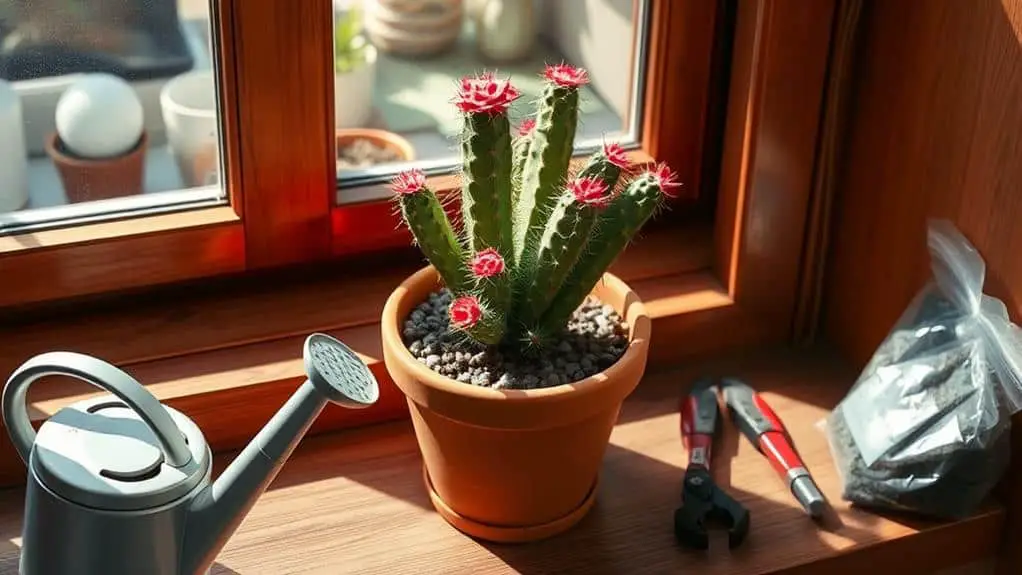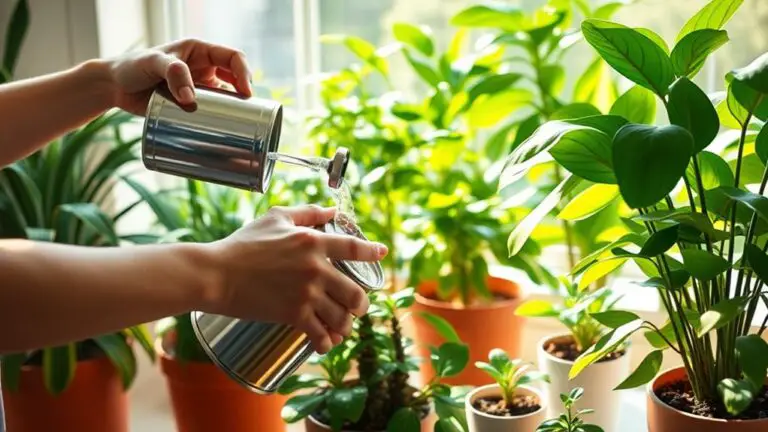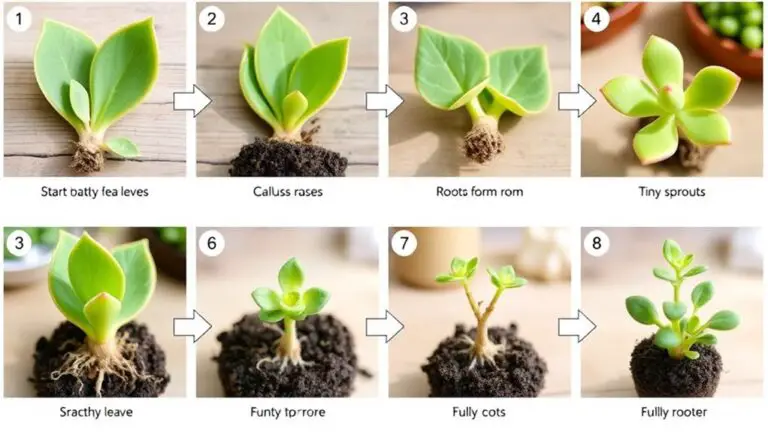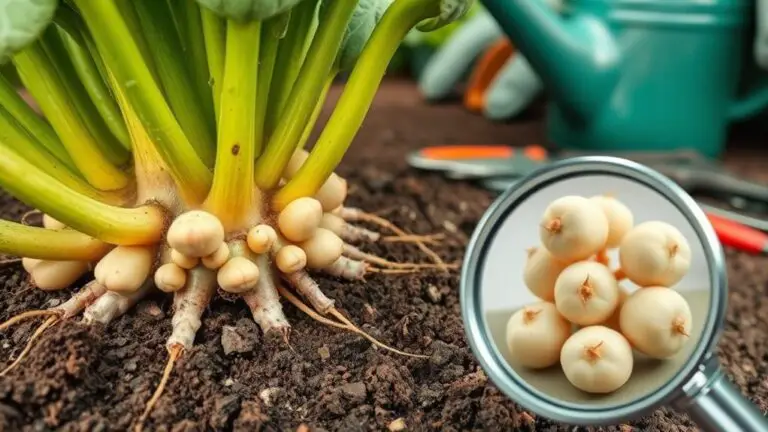7 Essential Steps to Take Care of Your Christmas Cactus
Taking care of your Christmas cactus isn't as intimidating as it might seem if you follow these seven essential steps. Start by understanding your plant's needs, especially its lighting requirements—bright, indirect light for 4-6 hours daily is vital. But lighting is just the beginning; maintaining the right temperature and humidity levels can make a significant difference in your plant's health. Curious about how to guarantee it's getting the proper nutrients and when to prune it for peak growth? Let's explore the finer details that will help your Christmas cactus thrive year-round.
Understand Your Christmas Cactus
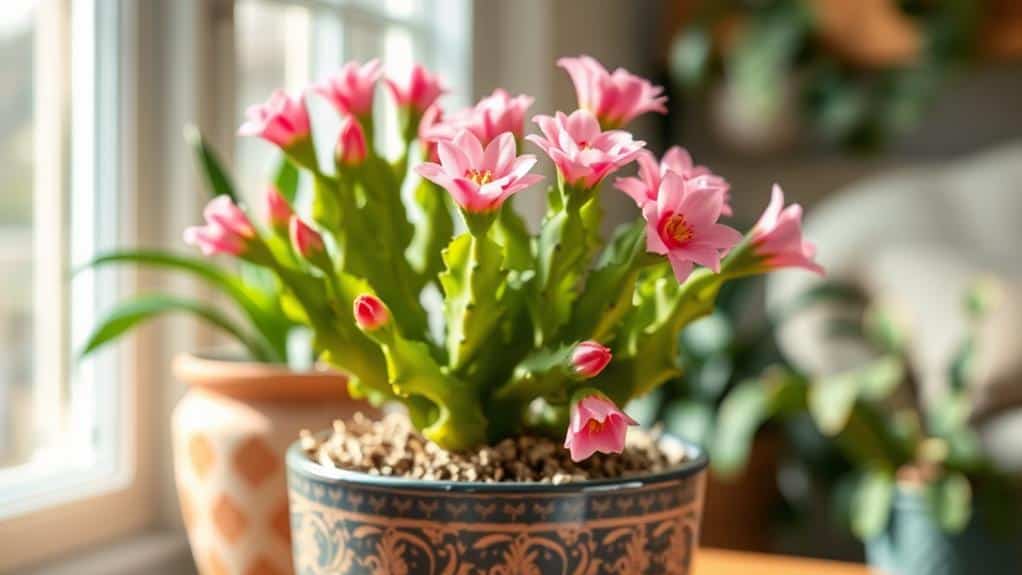
To truly care for your Christmas cactus, you need to understand its unique nature. The Christmas cactus, or Schlumbergera bridgesii, is a succulent that stands out with its hanging branches and flat green leaves featuring rounded teeth. Unlike most cacti, it thrives indoors and produces vibrant flowers around the Christmas holiday.
These flowers, which come in shades of red, pink, white, or purple, can reach up to 3 inches long and each bloom lasts several days, making it a long-lasting and beautiful addition to your home.
Your Christmas cactus differs from the Thanksgiving cactus and Easter cactus. While all three belong to the Schlumbergera family, they bloom at different times and have unique characteristics. The Thanksgiving cactus, for example, has notched stems, while the Christmas cactus has smoother, rounder edges.
To guarantee your Christmas cactus flourishes, you need to provide the right care. This plant can live for 20 to 30 years with proper attention.
Being a succulent, it prefers a well-draining soil mix and moderate watering. Remember, it's vital to let the soil dry out between waterings to prevent root rot.
With the right care, your Christmas cactus will reward you with stunning blooms year after year.
Provide Proper Lighting
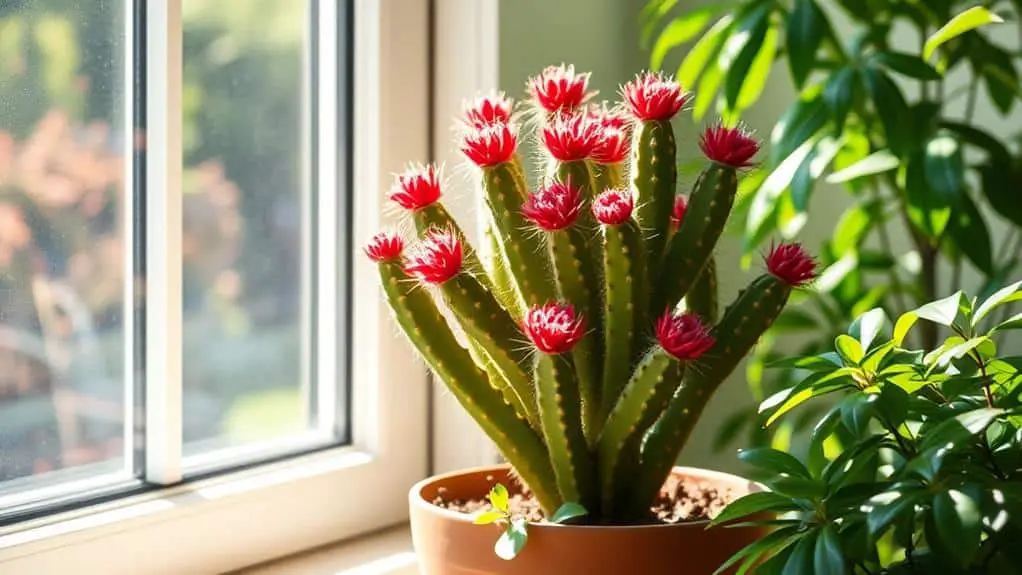
Understanding your Christmas cactus lays the foundation for providing the right care, and proper lighting plays a vital role in its health and blooming potential. Your Christmas cactus thrives in bright, indirect light. Place it in an east or north-facing window where it can bask in diffused sunlight without the risk of discoloration. During the blooming season, aim for 4-6 hours of this gentle light each day.
To encourage bud formation, guarantee the cactus gets at least 13 hours of darkness each night before the blooming season. If you notice buds aren't forming, adjust its placement. Moving it to a sunnier spot with about 10 hours of daylight, right after its dark period, can make a big difference.
Maintaining proper humidity levels, around 50-70%, can also enhance your cactus's flowering potential by mimicking its natural rainforest habitat. Here's a quick reference table for easy understanding:
| Lighting Aspect | Recommendation | Importance |
|---|---|---|
| Light Type | Bright, indirect light | Prevents leaf discoloration |
| Blooming Season Light | 4-6 hours diffused daily | Supports blooming |
| Dark Period | 13 hours each night | Essential for bud formation |
| Post-Dark Period Light | 10 hours sunlight exposure | Enhances flowering potential |
With these tips, you're well on your way to a healthy, blooming Christmas cactus!
Maintain Ideal Temperature and Humidity
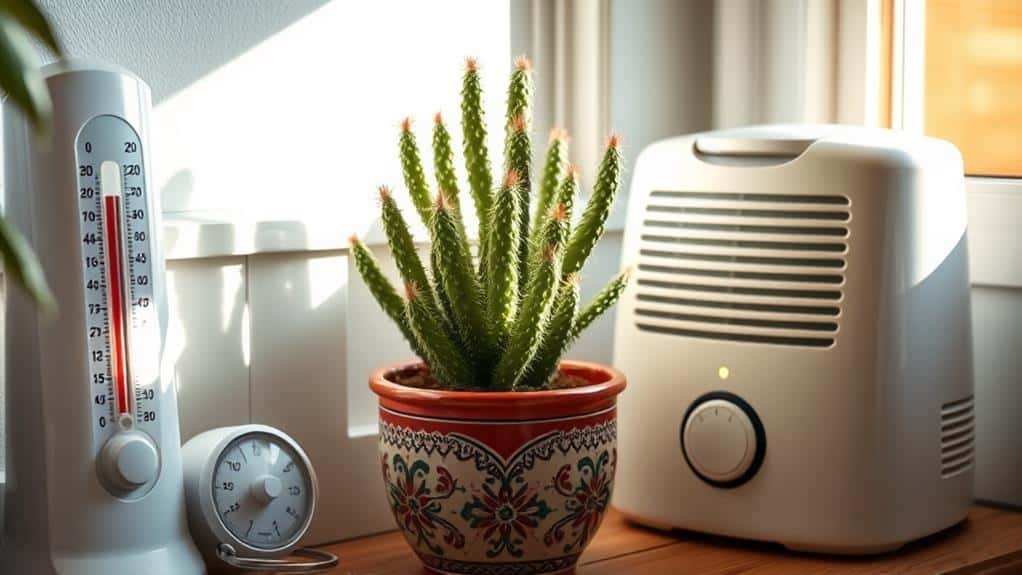
Keeping your Christmas cactus comfortable hinges on maintaining the ideal temperature and humidity.
The ideal temperature range for daytime is between 60-70°F, and at night, it should drop to 55-65°F. These cooler nighttime temperatures encourage flowering. It's important to mimic the cactus's natural rainforest habitat, where consistent conditions support healthy growth.
Humidity levels are equally significant. Aim for 50-70% humidity to keep your cactus thriving. You can achieve this by misting the plant regularly or placing it on pebble trays filled with water. These trays help maintain moisture around the plant, especially during dry seasons.
Avoid exposing your cactus to cold drafts or sudden temperature changes. These can stress the plant and negatively impact blooming.
During the flowering period, make certain the cactus receives at least 13 hours of darkness each night to encourage bud formation. This period of darkness is essential for the plant's natural cycle.
Water Correctly

Making sure your Christmas cactus thrives doesn't stop at managing temperature and humidity; proper watering is equally important. To water correctly, check that the top inch of soil is dry before watering. This prevents root rot by allowing the soil to dry out completely between waterings.
During the dormant period in late fall and winter, reduce watering frequency. Your Christmas cactus needs less moisture when it's not actively growing. Confirm your pot has drainage holes to let excess water escape, avoiding standing water that can harm the roots.
Use room temperature water to prevent shocking the plant. Misting leaves can also help maintain moisture levels during dry months. Keep an eye out for signs of dryness like puckering or shriveling leaves. If you see these signs, the plant might need more frequent watering, especially in sunny winter spots.
Here's a helpful summary:
| Step | Description |
|---|---|
| Check soil dryness | Water only when the top inch of soil is dry |
| Reduce watering in winter | Water less during the dormant period |
| Confirm pot drainage | Use pots with drainage holes to prevent standing water |
| Use room temperature water | Avoid shocking the plant with cold water |
| Mist leaves occasionally | Increase humidity, especially in dry environments |
| Watch for dryness signs | Look for puckering or shriveling leaves as indicators for more frequent watering |
Fertilize Appropriately
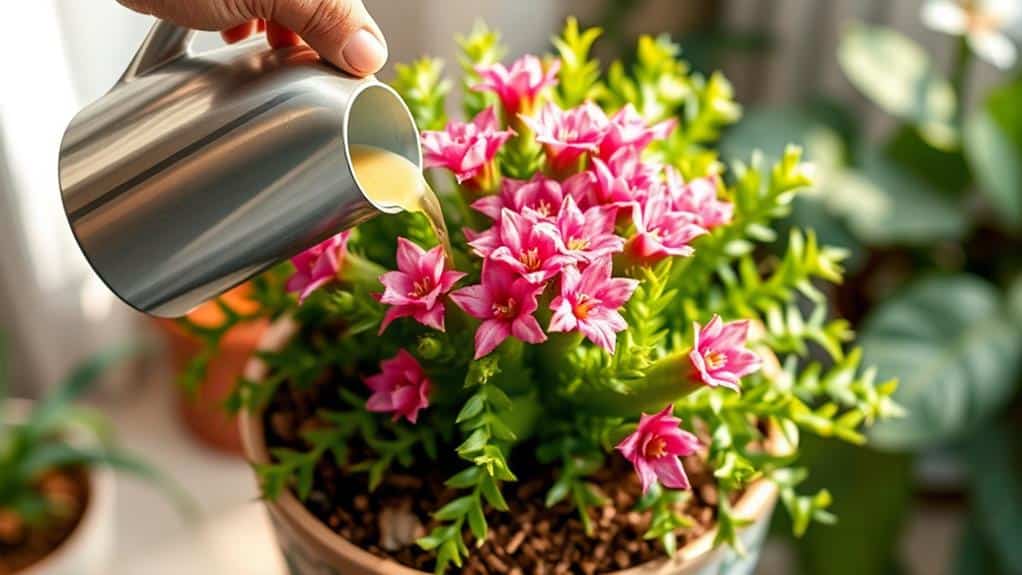
To keep your Christmas cactus thriving, fertilize it every two weeks with a balanced fertilizer like a 20-10-20 mix during the spring and summer.
Use a diluted solution at half strength to avoid overwhelming the plant.
In the fall, switch to a fertilizer low in nitrogen to help the plant form flower buds, and stop fertilizing during its dormant period in late fall and winter.
Balanced NPK Fertilizer
When it comes to keeping your Christmas cactus healthy and vibrant, a balanced NPK fertilizer is an important component. This type of fertilizer, like a 20-10-20 formulation, supports healthy growth during the spring and summer.
You should fertilize every two weeks from April until August to guarantee the plant gets the nutrients it needs during its active growth period.
Using a balanced NPK fertilizer helps prevent nutrient deficiencies. Without it, you might notice yellowing leaves or stunted growth.
As fall approaches, switch to a low nitrogen fertilizer, such as 0-15-10. This change encourages flower bud formation, getting your cactus ready for its blooming season.
However, it's vital to stop fertilizing during the plant's dormant period, which occurs in late fall and winter. Fertilizing during this time can cause stress on the plant instead of helping it.
Seasonal Feeding Schedule
During the growing season, your Christmas cactus thrives with a carefully planned feeding schedule. Start by fertilizing every two weeks in spring and summer with a balanced NPK fertilizer (20-10-20). This promotes healthy growth and encourages blooming.
Make sure to dilute the fertilizer to half strength to prevent nutrient burn, which can harm your plant. Consistent feeding during these active growth months leads to abundant blooms and a vibrant Christmas cactus.
When you fertilize regularly, your plant gets the nutrients it needs to flourish. This preparation is essential for the blooming season, setting the stage for beautiful flowers.
As the season shifts, switch to a low nitrogen fertilizer (0-15-10) in the fall. This change helps with flower bud formation.
Be mindful not to fertilize during the dormant period in late fall to winter. Fertilizing during this time can stress the plant, as it's not actively growing and doesn't need extra nutrients.
Low Nitrogen Fall
After establishing a solid feeding routine in the spring and summer, it's time to adjust your approach for the fall season. To get your Christmas cactus ready for the holiday season, switch to a low nitrogen fertilizer with a 0-15-10 ratio. This helps promote flower bud formation and keeps excess foliage growth in check.
Here's what you need to do:
- Apply Fertilizer Once in Fall: Use this low nitrogen fertilizer just once during fall. This will encourage the development of flower buds without making the plant too leafy.
- Keep Soil Moist: When you apply the fertilizer, make certain the soil is slightly moist. This prevents root burn and helps the cactus absorb nutrients effectively.
- Stop During Dormant Period: As late fall and winter approach, stop fertilizing. Your Christmas cactus enters a dormant period and needs a break to avoid stress.
Monitoring your plant's response to the fertilizer is key. Proper application during the fall can greatly boost its blooming potential when the holiday season arrives.
Prune When Necessary

Wondering how to keep your Christmas cactus looking its best? Pruning is a key step in maintaining a healthy and vibrant plant.
It's best to prune your Christmas cactus post-bloom, ideally in January or February. This timing encourages healthier growth and maintains the desired shape of your plant. When pruning, use the twisting-off method or clip sections at the point where two stem segments connect.
Regular pruning can enhance your cactus's flowering potential by promoting new growth. However, pruning isn't always necessary unless you want to control the size. Letting it grow naturally can also be a great option.
If you do decide to prune, remember to do it sparingly. Excessive cutting can stress the plant and hinder its blooming cycle.
Aim for a balanced approach. Pruning a few stem segments here and there can help manage size without affecting the plant too much. It's all about finding the right balance to keep your Christmas cactus flourishing.
Encourage Reblooming
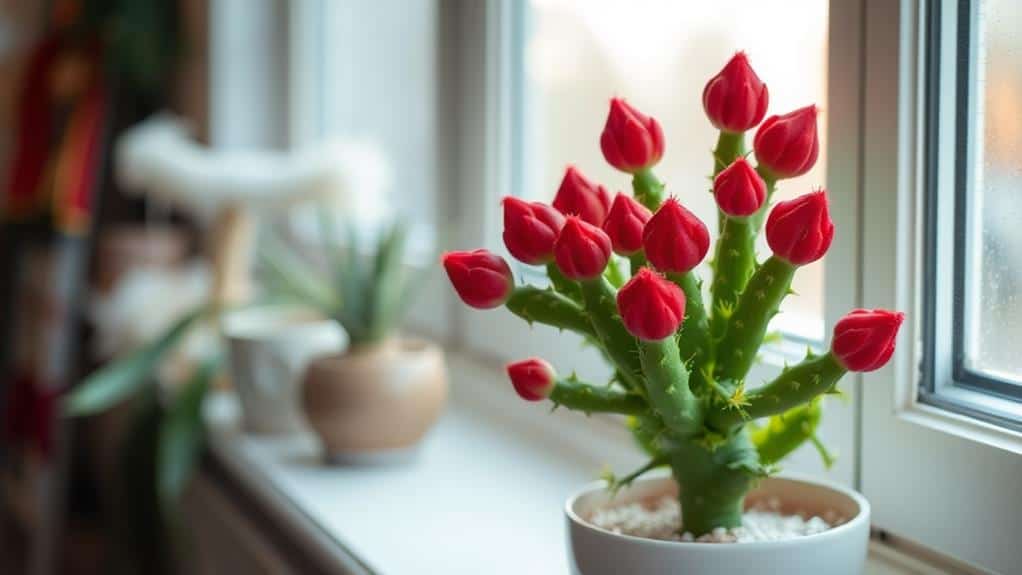
Encouraging your Christmas cactus to rebloom involves a few vital steps that can make a big difference.
First, you need to guarantee your cactus gets enough darkness. Provide it with 12 hours of darkness each night for about 6-8 weeks before you want it to bloom. This period of darkness is essential for preparing the plant for the upcoming blooming period.
Next, move your Christmas cactus to a spot with bright, indirect light for around 10 hours a day. This light exposure helps stimulate bud formation. Remember, keeping the light consistent is key. Frequent changes in the light environment can disrupt the blooming process.
The final step is to maintain cooler nighttime temperatures. Aim for temperatures between 55-65°F during the bud-setting phase. These cooler temperatures encourage the plant to produce more buds.
Here's a quick checklist to help you:
- Darkness: Guarantee 12 hours of darkness each night for 6-8 weeks.
- Light exposure: Move to bright, indirect light for 10 hours a day after the dark period.
- Cooler temperatures: Maintain nighttime temperatures between 55-65°F.
Frequently Asked Questions
How Do You Take Care of a Christmas Cactus Indoors?
You should place your Christmas cactus in bright, indirect light, water it when the top inch of soil is dry, maintain temperatures between 60-70°F, and fertilize bi-weekly in spring and summer. Guarantee humidity stays around 50-70%.
What Is the Best Way to Keep a Christmas Cactus Alive?
To keep your Christmas cactus alive, provide bright, indirect light, water when the top inch of soil is dry, maintain proper temperatures, fertilize during the growing season, and monitor humidity. Regular misting helps mimic its natural habitat.
How Often Should I Water a Christmas Cactus?
You should water your Christmas cactus only when the top inch of soil feels dry. In spring and summer, water more often, but reduce frequency in fall and winter. A moisture meter helps guarantee accurate watering.
How Do I Make My Christmas Cactus Grow Better?
To make your Christmas cactus grow better, give it bright, indirect light for 4-6 hours daily, maintain temperatures between 60-70°F, water when the top inch is dry, fertilize bi-weekly, and prune after blooming.
Conclusion
Taking care of your Christmas cactus isn't hard if you follow these steps. Give it bright, indirect light, and keep the temperatures just right. Water it properly, and don't forget to fertilize during the growing season. Prune it after it blooms, and provide darkness before the next blooming period. With a bit of attention, your Christmas cactus will thrive and bring joy to your home. You've got this—happy gardening!

